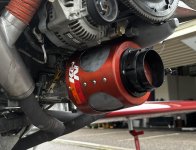David Howe tells me that Rod is apparently in declining health. I have one example of the very earliest Bower induction which Gene Evans sent me, with the idea that I would re-invent the components to make induction systems. It is a project on my list, and I know of a few folks that would like one if I can get the parts replicated. However, I do not plan to utilize the Reed valve design (see below).
The earliest Bower induction, as well as the one I made for my airplane, does not use the Reed valves. Rod's has a bypass duct that takes air from the ram inlet and bypasses the butterfly valve, putting air into the filter housing. Mine has an alternate air source from the left cooling intake ramp to the filter housing.
If you have the Reed valve type, and your Reed valves are not sealing when you are on ram induction, you are back-flowing through the filter and dumping ram flow into the lower cowl area. Not only will you experience a modest drop in manifold pressure, but you will develop cooling problems because by raising the lower cowl pressure, you reduce the cooling flow through the cylinders, oil cooler, etc.
You could seal up all but one of the Reed valve holes and put a duct on one of them to the left cooling intake ramp. The pressure there is almost as high as the ram pressure, so the back flow through the filter is very small.





